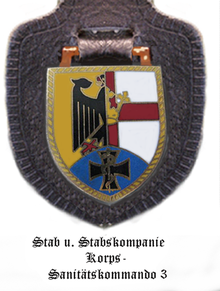Medical Command 3
|
Medical |
|
|---|---|
 ( did not have an association badge ) |
|
| active | 1972 to September 1993 |
| Country |
|
| Armed forces |
|
| Armed forces |
|
| Type | Medical Command |
| Insinuation |
|
| Staff seat | Koblenz |
The Medical Command 3 was one of the medical commands of the Army of the Bundeswehr . The headquarters were in Koblenz . The medical command was part of the corps troops of III. Corps .
assignments
The medical command bundled the medical troops of the army at the corps level . The order was primarily the medical care of the soldiers of the corps troops of III. Corps in a main dressing station to be set up for this purpose . The subordinate divisions and brigades led their own units of the medical service; Depending on the situation , the medical command supported these subordinate associations . The reserve hospital organization was the backbone of medical service in the army in the event of a defense and was organized by the medical commands of the territorial army . In the rescue chain of the Bundeswehr , the medical command occupied a middle position between the rear (reserve) hospitals of the territorial army and the main training stations set up closer to the advanced combat troops . In addition to the ambulances of the ambulance battalion the medical command had several rail-bound ambulance trains which the inside of the rescue chain transportation of the wounded were able to ensure. A medical supplies company of the ambulance battalion operated a corps supply point for medical supplies as a logistical link between the medical depots of the territorial army and the subordinate medical associations . Therefore, the company was sometimes referred to as the " Bundeswehr pharmacy ". The commander of the medical command as the chief medical officer of the corps and the subordinate medical officers advised the commanding general on medical and military medical issues.
In peacetime around 1989, the medical command consisted of only a few active units and only a few active soldiers. Instead, the stored device only had to be made mobile in the event of a defense or confiscated by civil organizations . An essential element for the growth was the drafting of reservists , including in particular reserve medical officers . Overall, the size of the medical command after the mobilization with about 2200 soldiers corresponded to about 50% of the size of one of the brigades of the field army.
structure
Around 1989 the medical command was roughly divided into:
-
 Staff / staff company Sanitätskommando 3, Koblenz
Staff / staff company Sanitätskommando 3, Koblenz
history
The medical command was set up in 1972 to take Army Structure III in Koblenz. The establishment was made by renaming and reclassification of the medical command 253, which from October 1st, 1958 to take over the Army Structure II at III. Corps had been planned.
After the end of the Cold War , the medical command was in September 1993 at about the same time as the III. Corps decommissioned. It was planned to use parts to set up a medical brigade 3; however, the formation was waived after the corps was dissolved. After the establishment of the Central Medical Service of the Bundeswehr , a new Medical Command III with Weissenfels staff was planned around 2001 , but despite the name, it was not in the direct tradition, let alone in spatial continuity, of the original Medical Command 3.
Association badge
Due to its planning as part of the dependent corps troops, the medical command did not have its own association badge . The soldiers therefore wore the association badge of the higher corps .
As a "badge", the internal association badge of the staff and the staff company " pars pro toto " was sometimes used imprecisely for the entire medical team. It showed the federal eagle on the right as in the association badge of the III. Corps, on the left the Koblenz city coat of arms with the Trier cross and the crown of the sky goddess , below on the blue weapon color of the medical service the Iron Cross as the national emblem of the Bundeswehr and the Aesculapian staff similar to the beret badge of the medical troops . The design shows certain similarities with the design of the internal association badge of the Bundeswehr central hospital .
Individual evidence
- ↑ a b O.W. Dragoons: The Bundeswehr 1989 . Army Office. I. Corps. II Corps. III. Corps. 4th edition. 2.1 - Army, February 2012 ( religte.com [PDF; accessed July 3, 2018]).
Coordinates: 50 ° 21 ' N , 7 ° 36' E
